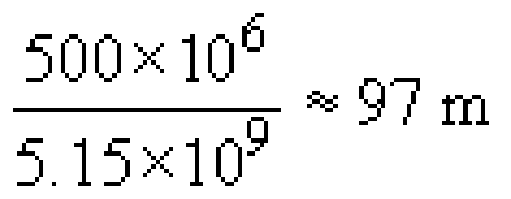4.5.2 10 Gigabit Ethernet
The standard for 10 Gigabit Ethernet (IEEE 802.3ae, lOGbE) was approved in July 2002. The main use of lOGbE, initially at least, is for backbone networks which interconnect 10, 100 or 1000 Mbit/s Ethernet hubs. These hubs might be widely separated geographically, so the standard includes physical layer specifications specifically for WAN (wide area network) applications as well as LAN applications. The WAN specification is for operation at slightly under 10 Gbit/s, 9.95328 Gbit/s, so as to be compatible with the SDH.
SAQ 15
What level in the SDH hierarchy runs at 9.95328 Gbit/s?
Answer
9.95328 Gbit/s is the transmission rate of STM-64.
Both the WAN and LAN physical layers can use optical interfaces specified for use at 850 nm, 1310 nm and 1550 nm as follows (Figure 31):
10GBASE-S operates with a directly modulated 850 nm multimode laser diode and graded-index multimode fibre, at distances up to 300 metres;
10GBASE-L operates with a directly modulated 1310 nm single-mode laser diode and single-mode fibre, at distances up to 10 km;
10GBASE-E operates with an externally modulated 1550 nm single-mode laser diode and single-mode fibre, at distances up to 40 km.

SAQ 16
If a 10GBASE-S interface used 50/125 mm fibre meeting the bandwidth-distance specification for Gigabit Ethernet of 500 MHz·km, approximately how far could the signal be transmitted? (The signalling rate of the 10GBASE-S interface is approximately 10.3 Gbaud.)
Answer
The minimum bandwidth that will allow a signalling rate of 10.3 Gbaud is:

The maximum transmission distance is therefore:

A target in the development of lOGbE was for a distance of at least 300 m on multimode fibre, and it is clear from the answer to SAQ 16 that this would not be possible with the 10GBASE-S interface on fibre that just meets the Gigabit Ethernet specification.
There are two solutions to this in 1 OGbE. One is to use new multimode fibre that has been developed with a higher specification, specifically for 1 OGbE. Referred to as ‘10 Gigabit Ethernet fibre’, this has a typical bandwidth-distance product of 2000 MHz·km.
Activity 18
What distance would be possible with this fibre?
Discussion
Repeating the calculation of SAQ 16 using the new specification leads to a distance of 2000/5150 = 388 m.
With this fibre the 300 m target can therefore be met (assuming that the power budget can also be balanced at 300 m).
The other solution is based on an additional interface specification, used only for the LAN physical layer (i.e. not the WAN physical layer), the 10GBASE-LX4 interface.
10GBASE-LX4 splits the data into four parallel streams and transmits them on four different wavelengths on a fibre. It therefore uses a type of WDM. The four wavelengths used are 1280 nm, 1300 nm, 1320 run and 1340 nm.
Activity 19
Into which of the ITU categories of WDM (CWDM, DWDM or WWDM) does this fit?
Discussion
The wavelength spacing (20 nm) makes it coarse wavelength division multiplexing, CWDM, although the actual wavelengths used are not those suggested in Recommendation G.694.2.
If you see reference to WWDM, make sure you know precisely what it means in context.
Unfortunately, although it most closely matches CWDM, the committee developing the IEEE 802.3ae standard chose to describe the scheme as wide wavelength division multiplexing, WWDM. The scheme most clearly does not fit with the ITU definition of WWDM.
10GBASE-LX4 can use either directly modulated multimode laser diodes or directly modulated single-mode laser diodes, and either multimode fibre (when it is specified to 300 m) or single-mode fibre (when it is specified to 10 km).
On multimode fibre it is capable of 300 m on existing (Gigabit Ethernet compliant) fibre.
